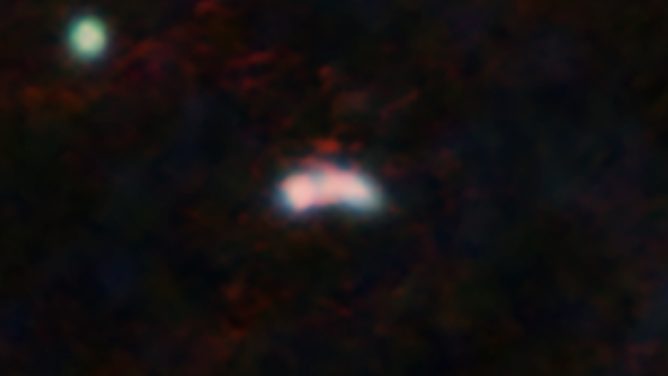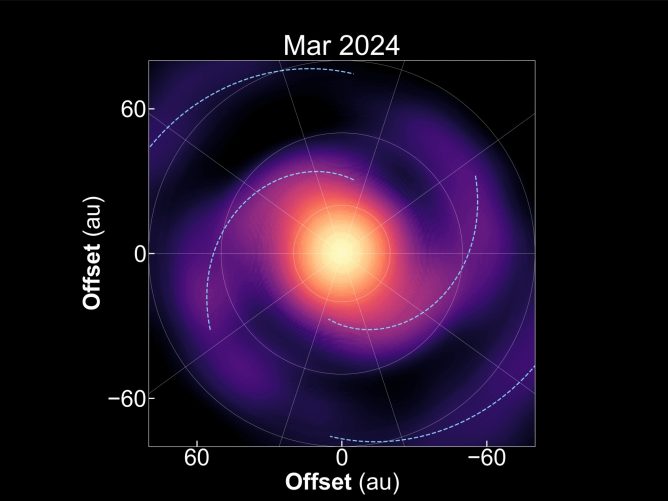2021.07.13
Do Supernova Explosions feed a Big Eater Black Hole?

Artist’s impression of an active galactic nuclei. A supermassive black hole is located in the center and surrounded by a gas disk. Observations indicate that supernova explosions occurred in the disk disturb the gas motion and helps the black hole to swallow the gas.
Credit: ALMA (ESO/NAOJ/NRAO)
Astronomers now believe that the center of every galaxy in the Universe today has a supermassive black hole that can be millions to billions times heavier than the Sun. The gas accreting to the supermassive black hole is heated to a high temperature through friction, resulting in enormous radiation. Such objects are so-called “Active Galactic Nuclei (AGN),” and the brightness of the AGN is simply proportional to the amount of gaseous material that is swallowed by the black hole per unit time. What surrounds the central black hole is a small molecular gas disk called the “circumnuclear disk”. Astronomers think that the radius of the circumnuclear disk is only a few hundred light-years from the central black hole. Recent observations with the Atacama Large Millimeter/submillimeter Array (ALMA) have shown that circumnuclear disks with more molecular gas tend to show a brighter AGN. Therefore, the molecular gas in the circumnuclear disk is thought to be the main supplier of material to the black hole. However, the gas in the circumnuclear disk generally rotates around the central black hole in one direction, like a carousel, meaning that the disk has “angular momentum (or centrifugal force)”. Therefore, unless the angular momentum is removed or weakened somehow, it is not possible to feed the gas into the black hole. What is then the physical mechanism to remove or weaken the angular momentum from the rotating gas?
Using ALMA, the research team observed the giant elliptical galaxy NGC 1275 (distance: 230 million light-years), located at the center of the Perseus cluster of galaxies, discovering a circumnuclear gas disk, just like other galaxies. The radius of the disk is about 300 light-years, and the total amount of molecular gas is about 100 million times the mass of the Sun. The team also studied the region of the circumnuclear disk using data obtained by the Very Long Baseline Array (VLBA) of the National Radio Astronomy Observatory in the U.S. The VLBA is an instrument that uses a technique called Very Long Baseline Interferometry (VLBI), which, like ALMA, is a collaboration of multiple radio telescopes, but the separation between the telescopes is much longer than ALMA. The VLBA observes centimeter waves, which have a longer wavelength than the millimeter/submillimeter radio waves observed by ALMA. It is ideal for detecting synchrotron radiation emitted by fast-moving, high-energy electrons interacting with magnetic fields. The synchrotron radiation is often observed along the jets emanating from a supermassive black hole and generally seen at a right-angle to the circumnuclear disk. However, to their surprise, the team found synchrotron radiation in NGC 1275 from the exact location where the circumnuclear disk is found. Since molecular gas cannot produce synchrotron radiation, high-energy electrons must somehow coexist with molecular gas in the circumnuclear disk. What is the origin of these high-energy electrons?
Molecular gas is the building block of stars, and the large abundance of molecular gas in the circumnuclear disk suggests that stars are forming in the same region. In addition, astronomers know that massive stars explode as supernovae at the end of their lives, producing many of high-energy electrons as an outcome. Therefore, the team’s new detection of synchrotron emission suggests supernova explosions in the circumnuclear disk. This is the very first direct observational evidence of such a phenomenon.

ALMA-VLBA composite image of the nuclei of the galaxy NGC 1275. Molecular gas disk around the black hole observed with ALMA is shown in orange, while high-energy electrons observed with the VLBA is shown in blue.
Credit: ALMA (ESO/NAOJ/NRAO), VLBA, H. Nagai and N. Kawakatu
Supernova explosions provide a large amount of energy to the surrounding interstellar gas. This is expected to produce a large degree of turbulence in the circumnuclear disk, weakening the angular momentum of the rotating gas. In fact, the team found that the turbulent velocity predicted from theoretical considerations is in good agreement with the observed turbulent motion derived from their ALMA observations. “The idea of using supernova explosions to weaken angular momentum has been proposed theoretically before, but we were very surprised by the good agreement between observation and theory.”, comments Nozomu Kawakatu, associate professor at National Institute of Technology, Kure College.
“Thanks to the high resolution of ALMA and VLBA, we were able to link two types of gas with very different properties – molecules and high-energy electrons – and get a clearer picture of the accretion mechanism into supermassive black holes. We hope to conduct similar studies in other active galactic nuclei in the future to further elucidate the relationship between supernova explosions and the cause of mass accretion into supermassive black holes.”, summarizes Hiroshi Nagai, a project associate professor at the National Astronomical Observatory of Japan.
Paper Information
These observation results were presented in H. Nagai and N. Kawakatu “Diffuse Synchrotron Emission Associated with the Starburst in the Circumnuclear Disk of NGC 1275” published by the Astrophysical Journal Letters on June 9, 2021.









